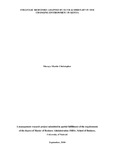| dc.description.abstract | Organization responses to the environment often involve change. For change to be successful it has to link the strategic, operational aspects of the organizations. Strategic responses can be seen as matching of the activities of an organization to the environment in which it operates. A strategic response affects the long term direction of the organization and requires large amounts of resources. It is aimed at achieving advantage for the organization and as such it is concerned with the scope of the entire organization activities
The study used qualitative and quantitative approaches and utilizing the descriptive survey design to collect the information data was collected by use of a semi-structured questionnaire and review of secondary data. The survey targeted eight managers in their respective branches and eight managers in the head office. 14 managers responded representing a response rate of 88%. Majority of the respondents in regards to the changing environment perceived industrial factors as the most challenging external environmental factors with a mean of 11 and the external factor perceived to least affect the company was social environmental factors with a mean of 8.
Pricing and Government funding as elements of customers tastes and preferences and Political/legal environment were found to be the most influential external environmental factors with a mean scores of 13 and 12.5 respectively compared to the least influential element of population growth and threat of substitute products each with a mean score of 6.25. The study also established that only ~9% of the respondents did not actively participate in formulation of response strategies adapted by Davis & Shirtliff, but were involved in the implementation of the organizations strategic plan. 90% of those that were not involved in the strategy formulation indicated that they would be more effective if they were involved during the process.
It was also established that 84% of the managers concur that Davis & Shirtliff adopts a reactive response to changes in the external environment rather than being proactive in the development of such response strategies. It can be concluded that the there has been a number of environmental changes which have adversely affected Davis & Shirtliff. To deal with these changes, the firm has laid out response strategies to counter the effects. Some of these have been entrenched in the strategic paper prepared by commercial director and rolled out in 2009 while the rest were implemented continually over the years as reactive response to these changes
Key words:- Strategic responses, Adapted, Davis & Shirtliff, Changing Environment, and Kenya | en_US |

